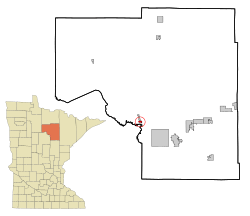Zemple, Minnesota facts for kids
Quick facts for kids
Zemple
|
|
|---|---|
| Motto(s):
"Where the Blacktop Ends"
|
|

Location of the city of Zemple
within Itasca County, Minnesota |
|
| Country | United States |
| State | Minnesota |
| County | Itasca |
| Area | |
| • Total | 0.65 sq mi (1.69 km2) |
| • Land | 0.65 sq mi (1.69 km2) |
| • Water | 0.00 sq mi (0.00 km2) |
| Elevation | 1,293 ft (394 m) |
| Population
(2020)
|
|
| • Total | 78 |
| • Density | 119.82/sq mi (46.29/km2) |
| Time zone | UTC-6 (Central (CST)) |
| • Summer (DST) | UTC-5 (CDT) |
| ZIP code |
56636
|
| Area code(s) | 218 |
| FIPS code | 27-72184 |
| GNIS feature ID | 0659083 |
Zemple is a city in Itasca County, Minnesota, United States. The population was 78 at the 2020 census.
Contents
Geography
According to the United States Census Bureau, the city has a total area of 0.80 square miles (2.07 km2), all land.
U.S. Highway 2 and Minnesota State Highway 6 are in proximity to Zemple. The city of Deer River is adjacent to Zemple.
History
Zemple was officially organized in 1911, with the first village council meeting held in June.
Early Zemple was a place where the former Minneapolis and Rainy River Railway had a roundhouse with 12 engines. Zemple had a store, a school (which closed in 1928), and a church.
The town was named for R. T. Zempel, who owned most of the land and was elected the first village president. The Zempels had a farm on the south end of the village. Other early residents included Martindales, Mayos, Simons, Nordahls, Dahls, Spragues, Johtonens, Nellis, Robertson, Blum, Reed, Folsom, Newkirks, Wrights and Berghs.
Lumber was the main industry in Zemple. There was a big sawmill on White Oak Point (a part of the Mississippi River), where logs where floated down to the sawmill. There was a planing mill, a veneer mill and a box mill, all of which burned down in later years. Excerpted from the Deer River Centennial History
The sawmill, referenced above. evolved under several different company names—Pillsbury-Watkins Company-1903, Joyce-Pillsbury Co.-1904, Deer River Lumber Co.-1906, eventually becoming Itasca Lumber Co. to its close in late 1921. ---from the book, Timber Connections—The Joyce Lumber Story—Bluewaters Press
Demographics
| Historical population | |||
|---|---|---|---|
| Census | Pop. | %± | |
| 1920 | 284 | — | |
| 1930 | 164 | −42.3% | |
| 1940 | 165 | 0.6% | |
| 1950 | 87 | −47.3% | |
| 1960 | 82 | −5.7% | |
| 1970 | 71 | −13.4% | |
| 1980 | 62 | −12.7% | |
| 1990 | 63 | 1.6% | |
| 2000 | 75 | 19.0% | |
| 2010 | 93 | 24.0% | |
| 2020 | 78 | −16.1% | |
| U.S. Decennial Census | |||
2010 census
As of the census of 2010, there were 93 people, 29 households, and 22 families living in the city. The population density was 116.3 inhabitants per square mile (44.9/km2). There were 30 housing units at an average density of 37.5 per square mile (14.5/km2). The racial makeup of the city was 93.5% White, 5.4% Native American, and 1.1% from two or more races.
There were 29 households, of which 48.3% had children under the age of 18 living with them, 58.6% were married couples living together, 13.8% had a female householder with no husband present, 3.4% had a male householder with no wife present, and 24.1% were non-families. 17.2% of all households were made up of individuals, and 6.8% had someone living alone who was 65 years of age or older. The average household size was 3.21 and the average family size was 3.59.
The median age in the city was 34.8 years. 36.6% of residents were under the age of 18; 2.2% were between the ages of 18 and 24; 26.9% were from 25 to 44; 19.4% were from 45 to 64; and 15.1% were 65 years of age or older. The gender makeup of the city was 53.8% male and 46.2% female.
See also
 In Spanish: Zemple para niños
In Spanish: Zemple para niños

